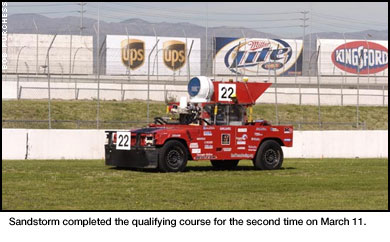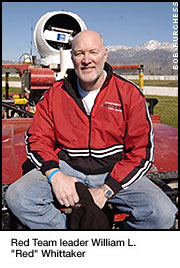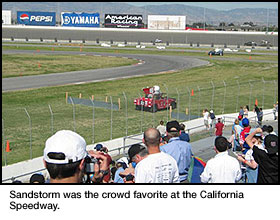|
|
||||
|
|

Sandstorm Earns Pole Position for $1 Million DARPA Grand Challenge Carnegie Mellon's Robotic Racer Completes Second Qualifying Run Reaching Top Speed of 39 MPH Carnegie Mellon's Red Team and Sandstorm, its autonomous 1986 Hummer, have earned the first starting position for Saturday's $1 Million DARPA Grand Challenge. In its second qualifying run at the California Speedway in Fontana, Calif., this past Thursday, Sandstorm completed the qualifying 1.36-mile obstacle course for the second time, reaching a top speed of 39 MPH.
Sandstorm, equipped with the world's fastest computers and best electronics in the world, is one of 15 teams to earn a spot in this unique competition.
To make it more difficult, the actual race course will be announced just two hours before race time. Once the course, a series of waypoints or checkpoints, is revealed, Red Team leader William "Red" Whittaker said his team will employ "an army of computing" to determine and send the best route to Sandstorm. The robot completing the course in 10 hours or less will win the $1 million cash prize. Sandstorm's "eyes" consist of a laser range finder for mapping terrain combined with a stereovision system for obstacle classification and for recognizing moving objects. These sensors ride on a "neck" designed to keep the robot's scanners on the road as it bounces through rough terrain. Sandstorm also scans the horizon with radar, which adds the ability to see through dust. In addition, there is a differential global positioning system (GPS) to help Sandstorm stay on course. This is tied to a high-fidelity map that the team will create and download when DARPA releases the waypoints for the course at 4:30 a.m., Saturday.
"This race will change the view of what's possible and introduce new robotic applications in the world," said Whittaker, the Fredkin Research Professor in Carnegie Mellon's Robotics Institute. Whittaker leads a group of some 50 Carnegie Mellon students, faculty and researchers as well as talent drawn from its pool of sponsors.
The challenge lies in sensing. Any Hummer can travel 210 miles in under 10 hours, but this one can only move as quickly as it can interpret the data it receives simultaneously from maps, radar and lidar scans. "We need to have excellent sensing capability," Red Team technology leader Chris Urmson said. "The computer ride will encounter hazards a human would avoid, so we've made computer modeling of this complex terrain a priority." Pre-mapping and routing strategies are directed by route leader Mike Clark, who describes them as "enabling capabilities for competing in the race." "We'll be using two terabytes of data to generate high-resolution maps of the desert," Clark said. "Our planning software will process the maps to classify the terrain, reach the waypoints, avoid difficulties, determine our speeds and optimize our route."
Satellite Feed:
On Carnegie Mellon CableTV, Channel 99: For more information about the Red Team, see: www.redteamracing.org For more on the evolution of Sandstorm, see: http://www.cmu.edu/corporate/news/2004/popups/RedTeam1.html To hear Red Whittaker's recent interview on National Public Radio (March 10), visit http://www.npr.org/features/feature.php?wfId=1755783 For more information on sponsors, see: www.redteamracing.org/sponsors For more information about the DARPA Challenge, see: www.darpa.mil/grandchallenge/
Lisa Kirchner & Anne Watzman
|
||
|
Carnegie Mellon Home |
||||
 The Grand Challenge, which begins at 6:30 a.m., Saturday, March 13, is a 210-mile off- and on-road race through the rugged Mojave Desert, from Barstow, Calif., to Primm, Nevada, near Las Vegas. Once the race begins no human intervention is allowed.
The Grand Challenge, which begins at 6:30 a.m., Saturday, March 13, is a 210-mile off- and on-road race through the rugged Mojave Desert, from Barstow, Calif., to Primm, Nevada, near Las Vegas. Once the race begins no human intervention is allowed.
 While some experts doubt the Grand Challenge can be completed this year, the Red Team and Sandstorm have been recently touted as top contenders in national magazines, such as Scientific American, Popular Science and Wired. Whittaker was recently interviewed on National Public Radio and many other national and international media outlets are knocking on his door.
While some experts doubt the Grand Challenge can be completed this year, the Red Team and Sandstorm have been recently touted as top contenders in national magazines, such as Scientific American, Popular Science and Wired. Whittaker was recently interviewed on National Public Radio and many other national and international media outlets are knocking on his door.